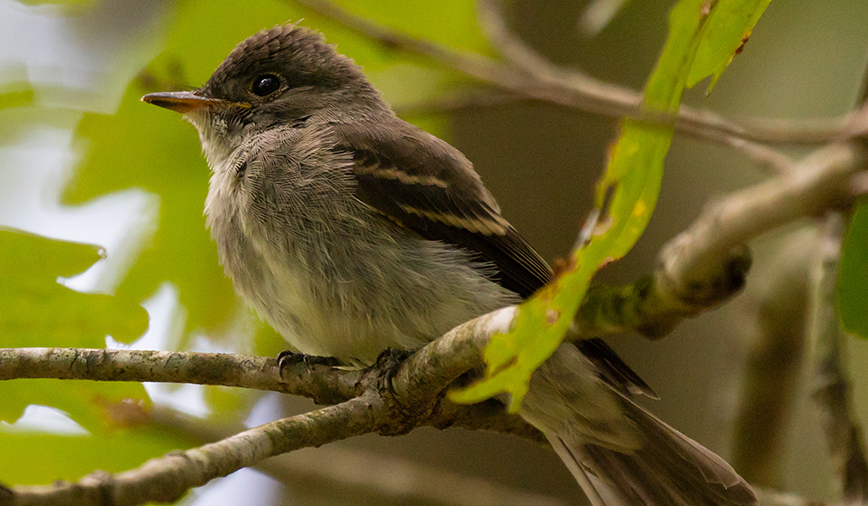Pam’s Perspective
From the…
Pam Otto is the Manager of Natural Programs and Interpretive Services for the St. Charles Park District
November 2, 2012
Wow. The facts blowing around in the aftermath of superstorm Sandy are staggering. The massive weather event took at least 160 human lives in the U.S. and Caribbean, knocked out power to 8.5 million U.S. customers and caused about $50 billion in damages
The storm wreaked havoc on air travel too, with airlines around the world cancelling flights or rerouting them away from the areas that were hardest hit.
Meanwhile, here in St. Charles, we can add at least one more flight to that list of cancellations: the southern migration of a young eastern wood-pewee, Contopus virens.
Our coworker Denis Kania, St. Charles Park District’s natural areas restoration manager and resident bird expert, happened to notice the little guy on Tuesday, the day our area experienced sustained winds in the 30 mph range.
Wind makes things tough for wildlife, and this bird was no exception. But even though it essentially was grounded, it made the best of things—and helped us out along the way.
During the warm weather months, eastern wood-pewees can be found in rich woods throughout our area, foraging for insects. As members of the Tyrannidae, or tyrant flycatcher family, pewees are exquisitely equipped to carry out their jobs—small bodies for quick maneuverability, and tweezer-like bills for plucking insects from mid-air.
They typically arrive mid-May and leave in late September and early October, times that coincide with the rise and fall of insect populations. So to be stuck here at the end of
October, after a few frosts have knocked back the bugs, is somewhat less than ideal.
What’s a stranded pewee to do?
Lucky for this little bird, the answer wasn’t blowin’ in the wind (like everything else was that day). To the contrary, the solution actually was stationary, or perhaps just slightly mobile: It was a mass of box elder bugs, the “queue,” as we’ve come to think of them, waiting for a chance to slip inside our building for the winter.
Denis first sighted the pewee from his office window, which faces south—the side of the building that faces a stand of box elder trees, and the area in which boxelder bugs are most likely to congregate. As time passed that afternoon, the pewee made its way along the siding and foundation of the building, plucking bugs as it went.
I can’t imagine that boxelder bugs ranked high on the little bird’s list of preferred foods; in fact, I’m not sure they normally would be on the list at all.
Boxelder bugs have bright red bellies—a characteristic that’s very obvious on immature individuals but somewhat less so on adults. At any rate, bright colors on insects usually indicate there’s some cause for concern –a venomous stinger, a toxic chemical in their hemolymph, or “blood.”
I don’t know exactly what’s going on inside a boxelder bug, but I do know they produce a mildly unpleasant odor when squished, and I can only imagine that this smell translates into an equally unpleasant oral sensation—something we humans refer to as taste.
At any rate, the young pewee was eating its fill of perhaps unpalatable but still protein-rich bugs, in preparation for the journey that lies ahead.
Eastern wood-pewees typically winter in northern South America, namely Columbia, Ecuador, Peru and Venezuela—destinations that are about 2,500 miles away. Figuring a migration flight speed of about 15 mph, for about 10 hours per day, the little bird should arrive at its destination right around Thanksgiving.
Let’s hope the bird will find a banquet of bugs there and, along the way, enjoy good luck and fair weather—and no hurricanes.

